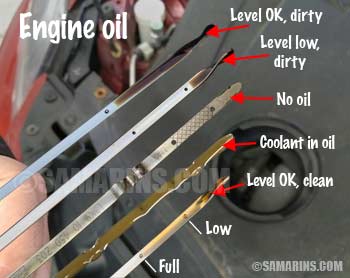
The used car market is full of great choices. From our experience, all used cars have some flaws or problems. Minor flaws can be dealt with, but cars that have major problems should be avoided. What's the difference?

The oil condition on the dipstick can tell a lot.
Minor flaws are the ones that don't affect the safety or reliability of the vehicle or the ones that can be repaired for a reasonable amount of money. Examples of minor problems include worn tires, suspension and brakes problems, noisy wheel bearings, old battery, scratches, dents, upholstery damage, etc.
Marking all minor flaws can help you in the negotiation process. You can request the dealer to repair all issues that you found or to lower the price accordingly.
Major problems include excessive rust damage, frame damage, engine or transmission problems, smoke from the exhaust, airbag and electrical problems, previous serious accidents, flood damage, a lack of maintenance or anything that makes the vehicle unsafe or might require expensive repairs in the future.
We wrote this guide to help you recognize signs of potential problems, make a more informed decision and avoid cars with major problems.
First, it's a good idea to check the reported history of the vehicle using the VIN number. There are several companies offering paid VIN history reports, Carfax is probably the most popular. The history report may show previous reported accident claims or other issues.
If the history report is "clean", it's a good start, but take it with a grain of salt. Not all accidents are reported and the history report will not show you the current mechanical condition of the vehicle. We have seen many used cars with "clean" history reports that in reality undergone some body repairs or had major mechanical problems.
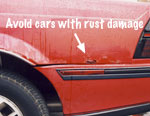
Repaired rust damage.
A small magnet might be useful in detecting repaired rust spots. You might also need a paper towel to check the engine oil and a USB cable or a CD to check the audio system.
If you are using a child seat, it's a good idea to take it with you to see if it fits.
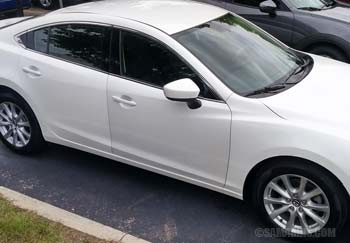
Can you tell what's wrong with this car?
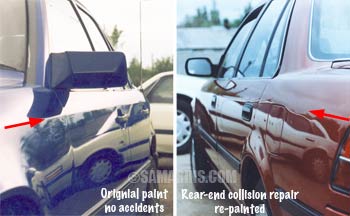
Look at the exterior lines. The car on the right has some waviness after a collision repair.
Look along the side of the vehicle. Do the exterior lines appear straight? Look at the reflection, you might be able to see the difference in paint texture or "waviness", which might be the evidence of previous body repairs.
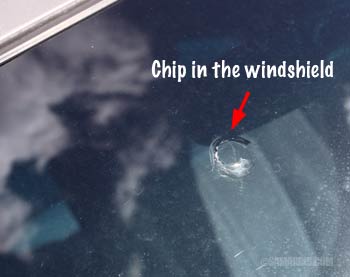
The cracks from this chip might spread later
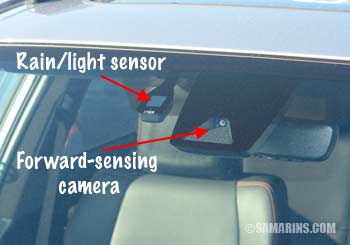
This car has a front-sensing camera and a rain sensor attached to the windshield.
Cars with advanced safety features, such as Lane Departure Warning or Front Collision warning, might have sensors attached to the windshield. If the windshield is replaced, some of the sensors (e.g. forward-sensing camera) might need to be re-calibrated.
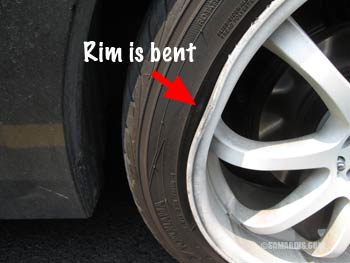
Some aftermarket low-profile rims bent easily.
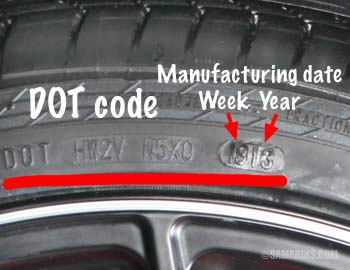
This tire was manufactured in the 19th week (May) of 2013.
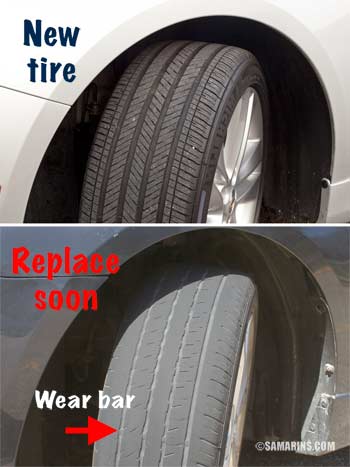
New versus worn-out tire
Do tires look worn out? Do they have cracks, cuts, bubbles or other damage in the sidewall? Tires with sidewall damage must be replaced. Watch out for uneven wear; it might be a sign of problems with the suspension or wheel alignment.
The tire in the top image is almost new. The new tires have a tread depth from 10/32" to 11/32" and can last for up to 40,000 miles. The tire in the lower photo might still pass the safety inspection, but is worn out to about 4/32", which means this car will need new tires soon. Look at the wear indicator bar.
A set of tires, depending on the size and brand costs from $400 to $1400 to replace. Low-profile 18" and larger tires are more expensive. Run-flat tires cost a lot too. You can look up prices at TireRack.com.
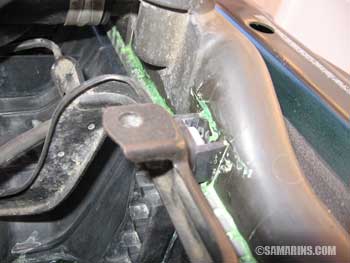
Coolant leaking from a crack in the radiator.
Before checking under the hood, make sure the engine is OFF, the transmission is in Park and the parking brake is applied.
Watch out for:
• Leaks (avoid the car if you notice major leaks).
• A burnt oil or antifreeze smell (avoid the car).
• Anything that suggests that the car has not been regularly maintained.
• Signs of sloppy repairs (avoid the car).
• Mods suggesting the car has been raced or otherwise abused
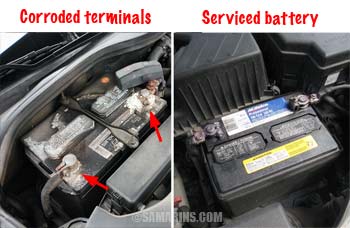
The battery in the left photo looks corroded. The right photo shows the battery that has been recently serviced.
The condition of the battery is one of the indicators of the level of maintenance the car received. Do the battery terminals look corroded or recently serviced? If the battery looks old, it will need to be changed soon.

The oil condition on the dipstick can tell a lot.
If you are not comfortable doing these tests, leave them for the mechanic. Make sure the engine is turned OFF and the parking brake is applied. Check the vehicle's owners manual for directions.
Find the engine oil dipstick. Usually it has a bright handle that says" Engine Oil." Pull the dipstick out and check the oil level and condition. If the oil looks very dirty and the oil level is low, it means that either the engine consumes oil or has been poorly maintained.
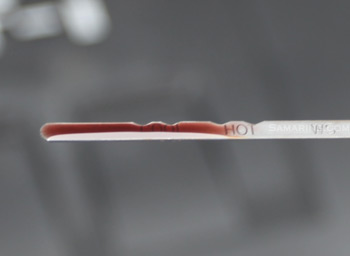
In this car, transmission fluid looks a bit dark, but still clean. The level is OK
If the car has a transmission fluid dipstick (many modern cars don't have one), check the transmission fluid condition. To see better, drop some fluid on a white paper towel.
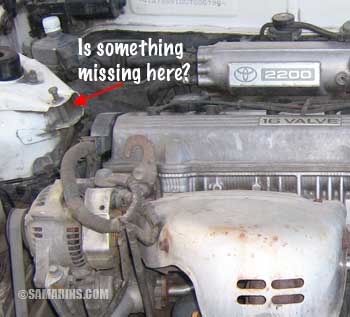
Watch out for sloppy repair job
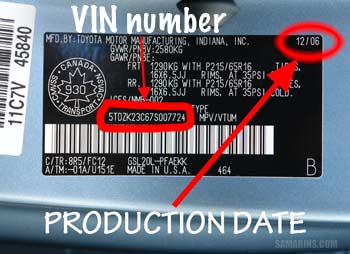
The car is a 2007 model, but it was built in December 2006.
Take a photo of or write down the VIN number. You can find the VIN number in the lower left portion of the windshield or on the manufacturer's sticker. See where the VIN sticker is located. You will need the VIN number to check for any outstanding recalls.
Do the steering wheel, driver's seat and the inner door handle look worn out? Does it smell bad inside the car? Bad interior odors are difficult to get rid of. Check the condition of the seats.
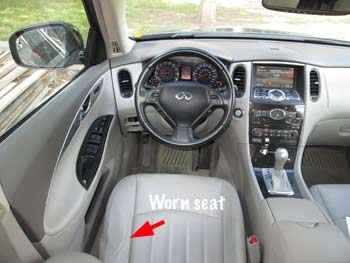
The driver's seat looks excessively worn
Look for wear, burn marks and other damage.
Minor damage can be repaired; ask if the dealer can arrange for repairs. Check if both front seats slide and recline. Check the condition of the seat belts. Do you feel comfortable in the driver's seat? Can you find a comfortable position using the steering adjustments?
Test power windows, power locks and mirrors. Sometimes a window goes down well, but goes up very slowly or crooked. Loud abnormal noises when a power window is operated indicate a problem. Test the front and rear wipers and washer functions.
Take some time to test the infotainment system functions. Try pairing up your phone if that's important to you. See if the rear-view camera provides a clear image. Check if the speakers don't rattle when turning up the volume.
Test the heater and air conditioner. With the engine running, turn the A/C on.
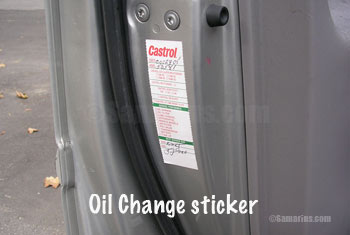 Oil change sticker" width="350" height="235" />
Oil change sticker" width="350" height="235" />
An oil change sticker may shed some light on the maintenance history.
You should feel cold air coming from the vents soon after the A/C is turned on. Normally when you turn the A/C on, you might notice that the engine tone changes; it's because the A/C compressor engages.
Watch out for musty smells from the vents.
A burnt oil smell from the vents indicates possible oil leaks in the engine compartment. An antifreeze (coolant) smell is a sign of a coolant leaks. Leaks are signs of problems, it's best to avoid a car.
If the vehicle has a separate HVAC system for rear-seat passengers, test it too.
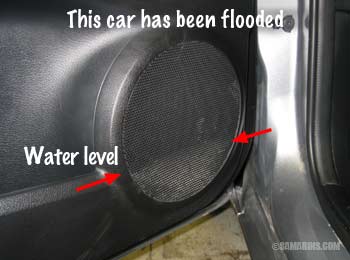
This car has been flooded. You can see the water level mark in the speaker cover. Photo 2.
Floods are becoming more common. If a car has been flooded, it's more likely to develop many problems in the future. Modern cars have many electronic components that can get damaged if submerged under water.
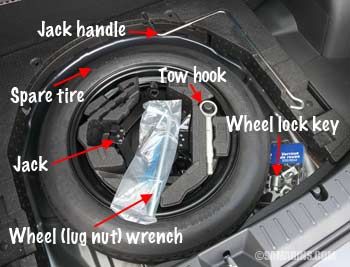
Check if the wheel lock key and the tools to change a tire are present.
A new car comes with at least two keys or key fobs; ask if the second key (fob) is available and test if both are working. If there is only one key, and it's lost, the car would have to be towed to the dealer to cut and program a new key (fob). This will be expensive.
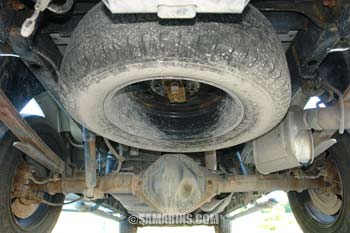
This truck has a spare tire secured underneath.
There are many problems that you can find during a test drive. Test drive for as long as possible to be able to assess the driving characteristics of a vehicle. It's not uncommon for used car buyers to request a second test drive before signing a contract. We wrote a separate post: Signs of automatic transmission problems when test driving a used car.
We recommend having the vehicle properly inspected by a knowledgeable mechanic before purchase. There are many components that can only be inspected when the car is lifted on the hoist. An important question for any used car in the Rust Belt and Canada is how bad is the rust damage underneath and has the vehicle been rust proofed?
How to get the vehicle inspected in a shop? Many used car buyers arrange to have a pre-purchase inspection done by a local mechanic or new car dealer specializing in that brand. It may cost from $75 to $150.
If possible, speak directly to the technician doing the inspection for the explanation of any findings and for general opinion on the car. You might also be able to find a used car inspector who can inspect the car on the spot.
Discuss any issues that need to be addressed before signing the contract. For example, if there are scratches or other minor damage, discuss if the dealer can repair it or reduce the price.
If the car needs new tires, discuss in detail what kind of tires will be installed: cheap ones or from a reputable brand? If there is only one key, will the dealer provide the second key? It's best to do this in writing; verbal promises are just that, verbal promises. The same goes for warranty, check the contract and see what is covered.